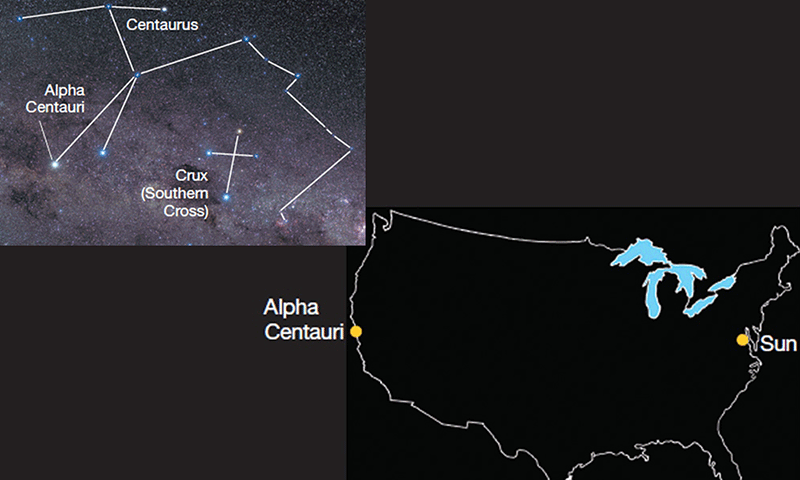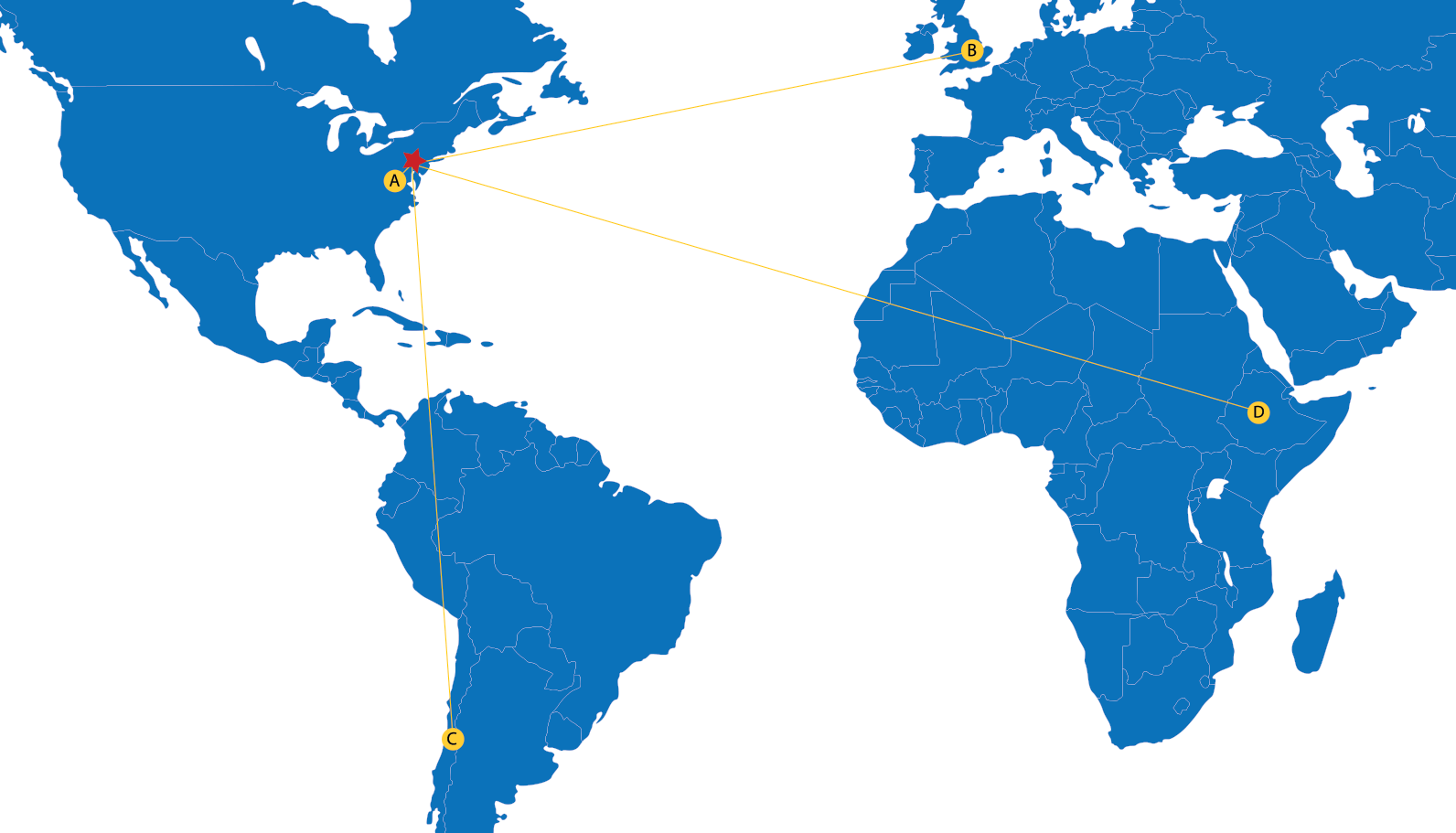If you visit the Voyage scale model solar system in Washington, DC, and start at the grapefruit-size model Sun, you can walk to the model Earth in only about 15 seconds, and reach the outermost planet, Neptune, in about 10 minutes. Suppose you want to keep going beyond our solar system to walk to the next grapefruit-size star on the same 1-to-10 billion scale. How far will you have to go?
Journal Entry
Start With a Guess
For today’s page in your journal, create an entry titled “Distance to the Stars.” Then write and complete the following sentence in your journal:
“On the 1-to-10 billion Voyage scale, the distance from the Sun to Neptune is about 600 meters. On this same scale, my guess for the distance to the nearest star besides the Sun is about _____.”
Please don’t continue until you’ve made your guess and written it in your journal!
OK, now that you’ve made your guess, let’s figure out the correct answer together.
Step 1: Look up the actual distance to Alpha Centauri, which is the nearest “star” that we see in the night sky. (Alpha Centauri actually consists of three stars that look like one star in the night sky; the largest of the three is about the same size as our Sun, making it another grapefruit on the model solar system scale.)
Alpha Centauri is about 4.4 light-years away.
Step 2: Figure out how far a light-year is on our 1-to-10 billion scale.
Recall that 1 light-year is approximately 10 trillion (10,000,000,000,0000) kilometers. To find the scaled distance for 1 light-year, we divide the real distance by 10 billion (10,000,000,000). To make our work easier, we write the numbers without commas and cancel all the zeros that appear in both the numerator and denominator:
| 10,000,000,000,000 10,000,000,000 |
= | 1,000 km |
We see that on the 1-to-10 billion scale, one light-year is about 1,000 kilometers.
Step 3: Figure out Alpha Centauri’s distance on the 1-to-10 billion scale.
Because 1 light-year is about 1,000 kilometers on this scale, Alpha Centauri’s distance of 4.4 light-years is about 4,400 kilometers.
Our answer shows that if you start at the model Sun in Washington, DC, you would have to walk about 4,400 kilometers to reach the next grapefruit-size star on the same scale. How far is that? If you look at a map or globe, you’ll find that it is approximately the distance across the continental United States. In other words, on the same scale in which you can walk the length of our planetary system in only about 10 minutes, you’d have to cross the United States to reach the next star.

Journal Entry
(Continued from above)
Add a sentence or two to today’s journal entry to describe how your guess compared to the correct answer. You can also add notes about what you’ve learned about the incredible distances to the stars.
Another way to think about the tremendous distances to stars is to consider spacecraft travel. The New Horizons spacecraft was sent into space at a speed of about 50,000 kilometers per hour, which is about 100 times as fast as a “speeding bullet”! Even so, New Horizons took more than 9 years just to reach Pluto, which is still part of own solar system. New Horizons is now continuing on its journey outward from Earth, but despite its high speed, it would need almost 100,000 years to travel the distance to the nearest stars. Science fiction shows like Star Trek and Star Wars may make interstellar travel look “easy,” but in fact it remains far beyond our present technology.
The tremendous distances to the stars may be too far for us to travel today, but they provide perspective on the amazing telescope technology that we already have. Think about planets orbiting one of the stars of Alpha Centauri. On our scale, they would range in size from tiny dots (like Earth) to marbles (like Jupiter), and unlike the star they orbit, they give off no light of their own. Discovering these planets would therefore be equivalent to looking through a telescope from Washington, DC to San Francisco (and ignoring the curvature of the Earth) and discovering that dots or marbles are orbiting a grapefruit. It might sound impossible – but we can now do it, and astronomers have already discovered many thousands of planets orbiting other stars (including at least one in the Alpha Centauri system).
Connections—History
Recognizing Earth’s small size.
Dutch astronomer Christiaan Huygens (1629–1695) made what was probably the first reasonably accurate estimate of the distances to the stars, and this also made him the first to realize how small our own Earth is in comparison. He did it by making tiny holes in a plate that he used to block the Sun, so that only a tiny amount of the Sun’s light came through the plate. By identifying the hole that he thought let in the same amount of light that we would see at night from the bright star Sirius, he estimated that Sirius is about 1/30,000 as bright as the Sun, and therefore that it must be 30,000 times as far away as the Sun, which turns out to be about half a light-year. This underestimates Sirius’s actual distance of about 8 light-years, in part because Sirius is actually a brighter star than our Sun. Still, it showed that the stars are much farther away than anyone had realized, which led Huygens to understand that Earth must be very small in comparison to the universe. Here’s what he wrote about this fact, way back in 1690:
“How vast those Orbs must be,
and how inconsiderable this Earth,
the Theatre upon which all our mighty Designs,
all our Navigations,
and all our Wars are transacted,
is when compared to them.
A very fit consideration,
and matter of Reflection,
for those Kings and Princes
who sacrifice the Lives of so many People,
only to flatter their Ambition in being Masters
of some pitiful corner of this small Spot.”
Quick Quiz
Note: As always, after you finish the quiz, be sure you read the feedback that explains the correct answers, to make sure you understand the reasons for these answers.
